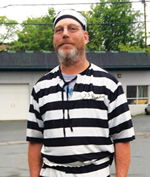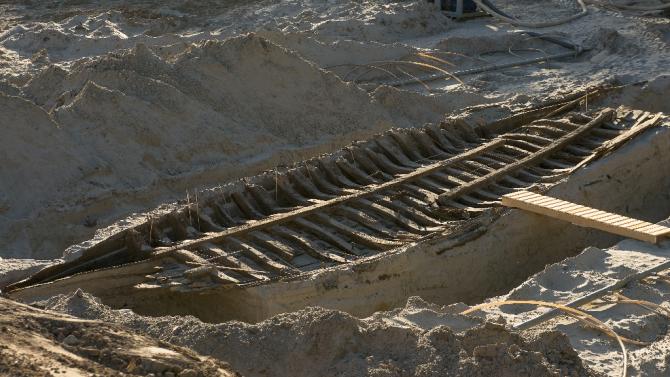In proposing that Incans practiced brain surgery—something even the
best European and American doctors struggled with—and positing that
ancient American civilizations were as advanced as ancient Egypt and
Rome, Squier was gambling with his reputation. At the time, there was a
pervasive prejudice against Amerindian tribes, who had long been
dismissed as loin-clothed savages wielding crude tools. This was
tangible proof otherwise. And Squier was willing to do anything—cross
colleagues, forgo his dignity, sacrifice his marriage—to make the rest
of the world understand.
The Guano Problem
The funny thing
is, Squier hadn’t traveled to South America to learn more about
ancient neurosurgery or to combat stereotypes. No, Squier had come to
South America to settle something far more serious: an argument about
bird poop.
Throughout the 1800s, farmers used natural fertilizers
to grow crops. The best fertilizers came from islands off South
America, where mountains of guano had piled up over eons. Guano proved
so important to global health and economics—millions of dollars were at
stake, not to mention the health of millions of hungry people—that
Chile, Bolivia, and Peru actually went to war over bird excrement in
1879.
For
most of the 1800s, the U.S. imported thousands of tons of guano per
year, and with the outbreak of the Civil War in the 1860s, securing
fertilizer to help guarantee a steady supply of food became a necessity.
But a number of international incidents (one involving Confederate
pirates seizing Peruvian ships and destroying guano cargo) had angered
Peru, and the government was threatening to cut off the pipeline. The
situation forced Abraham Lincoln to address the United States’ guano
deficit head on. He dispatched a delegation to Peru in July 1863, and
Squier, who had served as a diplomat in Central America, was a natural
choice.

Squier spent five months untangling the legal claims in
Peru. Having succeeded, he then sent his wife, Miriam, home to New York
and set out to explore his real interest, the country’s buried
artifacts and vine-choked ruins. Over the next 18 months, he traveled
everywhere from the coast of Peru to the peaks of the Andes deep in the
interior. He saw mountain fortresses, llamas, and statues and
artifacts of every kind. The trip culminated with a visit to Señora
Zentino, which was when the idea of ancient neurosurgery grabbed him.
Squier
saw the holes as evidence of trepanation—a procedure in which surgeons
cut out a pocket of the skull to relieve internal pressure and remove
sharp fragments of bone. Western doctors had been trepanning skulls as
far back as ancient Greece, and it had a brutal reputation. Medieval
doctors plugged patients’ ears with lint so they couldn’t hear their
own heads being sawed open. Few people who endured trepanation
survived. By 1700, most clinics had abandoned the procedure. As one
British surgeon declared in 1839, any doctor who proposed trepanning
someone “ought to be trepanned in turn.”
Squier’s
claim, then, seemed iffy—if the best European surgeons couldn’t pull
off trepanations, how could so-called primitive jungle tribes? But
Squier was convinced. After returning to New York in 1865, he showed
the skull to colleagues and outlined his theory. In the debate that
followed, some sided with Squier, while others derided the idea.
Undeterred,
Squier appealed to the highest scientific authority around, French
neurologist Paul Broca. Broca had recently achieved worldwide fame by
discovering the first-known language center in the brain, now called
Broca’s area. The Frenchman shared Squier’s passion for archaeology,
especially for skulls, and in 1867, he snapped up Squier’s offer to
examine the Incan skull.
Broca’s conclusions were unequivocal:
Squier was correct. The shape of the hole could not have been natural
or accidental, and he confirmed that new bone had grown around the rim.
Broca’s medical eye also found signs of inflammation, further evidence
that the patient had survived.
Broca forced scientists in Europe
to confront the possibility that ancient people had developed their own
sophisticated medical practices. Soon, other archaeologists started to
notice trepanned skulls in their collections, some potentially dating
back 10,000 years. Most of the holes were small and circular, but some
gaped as wide as five inches across. Many had rims completely smoothed
over by new bone growth, indicating that the patients had lived for
years after. Skulls with multiple trepanations even turned up. One
unlucky Incan fellow had seven separate holes in his head, all
perfectly healed. But as archaeologists embraced Squier’s theory, a
bigger mystery emerged: Why were civilizations performing trepanations
in the first place?
Trepanation: A How-To Guide
Before
they could tackle why, archaeologists needed to understand how. Over
the years, Incan pots with images of trepanations had turned up.
Additionally, evidence from rural Kenya, New Guinea, and similarly
remote areas showed that other tribes were also proficient in the
practice.
The procedure looked something like this: Imagine a
young warrior hit in the head with a slingshot stone, which left a
crater of mangled bone. A surgeon would clamp the young man’s head
between his knees, crack open a coconut, and pour the juice on the
scalp. The doctor, meanwhile, would dab fresh-cut leaves on the wound
to dull the pain.
Then he’d get to work,
using a shark tooth or something sharp to cut into the skull, grooving
it round and round the depressed fracture, carefully working the
incision deeper. Throughout the process, the warrior would gulp alcohol
or consume tobacco to quell the discomfort. He would feel almost
nothing after the initial pain: just the friction of the shark tooth
against his skull. At last, the warrior would experience a slight
sucking sensation as a plug of skull bone came free. With bamboo
fashioned into forceps, the surgeon would pick out the bone splinters
and wash the wound with coconut milk. He’d sew up the scalp with a
needle and thread made of bat bones and banana fibers. A dressing of
leaves and a plaster of pepper, lime, and betel nut might seal the
wound. Finally, the patient would be instructed to eat soft foods for a
week and minimize the movement of his head.
As
with today’s procedures, managing pain and infection were the biggest
concerns, but surgeons had measures to combat these. The coca leaves
helped anesthetize the skull. Similarly, wild plants like balsam killed
bacteria, as did washing wounds with coconut milk. In fact, ancient
surgeons did a remarkable job with sterilization: In one study of 66
trepanned skulls, just three showed any signs of infection. These
surgeons had a better track record than their counterparts in
industrialized countries. In one survey from London in the 1870s, 75
percent of neurosurgical patients died, mostly due to infections.
Compare that to the New Guinea tribes, where surgeons lost just 30
percent of their patients.
THE SPIRIT THEORY
Why ancient
cultures performed neurosurgery remains controversial. After years of
studying skull holes, Broca concluded that doctors had trepanned skulls
primarily to release spirits trapped inside the brain. Moreover, he
hypothesized that they operated mostly on children, a claim he based on
a macabre experiment. Using sharp glass, Broca managed to open the
skull of a recently deceased 2-year-old in four minutes. Cutting a
similar hole in an adult skull required 50 minutes, and his hand ached.
Broca concluded that ancient surgeons lacked the patience and tools to
cut through adult skulls and therefore must have limited the procedure
to children, who grew up with holes in their heads.
But most
scientists doubt Broca’s conclusion, partially because few trepanned
child skulls have ever turned up. Broca’s theory that trepanation
released evil spirits, however, proved enormously influential. This
idea played into stereotypes of ancient people. And, in truth, many
tribes—despite wildly different supernatural beliefs—probably did
trepan people to treat epilepsy and hallucinations, maladies often
associated with spirits.
Squier and other archaeologists always
doubted the spirit theory, however. They promoted an alternative: that
ancient neurosurgeons were removing bone fragments from injuries
sustained during combat. Modern research has provided strong evidence
for this, especially among the Inca. For one thing, far more males than
females had trepanation holes, likely because most warriors were
males. For another, the holes were usually located on the left side of
the skull—where a right-handed assailant would aim a slingshot or smash
his club.
From a modern medical perspective, the idea makes
sense: Doctors today still trepan people to reduce pressure on the
brain after injury. The practice is meant to reduce swelling and the
buildup of blood and other fluids, which can kill brain cells.
In
the end, Squier bested Broca in the debate over why ancient
neurosurgeons cut open skulls. But while Broca continued to have a
glorious career, Squier’s unraveled not long after his discovery—as if
the skull really were cursed.
Sad State of Squier's Affairs

It
all started when Squier sent his wife, Miriam, home from Peru after
the guano affair. Alone and resentful, Miriam accepted a job editing
magazines for publisher Frank Leslie, and the two became inseparable.
After his divorce in 1866, Leslie moved in with her and Squier. This
seemed suspicious enough, but things really turned nasty in 1867 when
the trio took a trip to Liverpool. Squier had some outstanding debts in
England, and, humiliatingly, the police arrested him the moment he
stepped ashore. An “anonymous” tipster—likely Leslie—had wired ahead to
alert his creditors. With Squier out of the way, Leslie and Miriam’s
affair began in earnest.
In May 1873, Miriam finally divorced
Squier after publicly accusing him of sleeping with two prostitutes.
Free of her husband, Miriam married Leslie in July 1874—a betrayal that
broke Squier’s spirit. Just one month later, he had deteriorated to
the point that a judge temporarily committed him to an insane asylum.
Squier died at his brother’s home in Brooklyn in 1888. He was 67.
It
was a sad, sordid end for one of America’s greatest archaeologists.
Still, Squier did accomplish his life’s goal. He hadn’t thought much of
Lincoln’s assignment in 1863, grumbling that guano “has contributed
more towards the corruption of [Peru] than any one other thing.” But
his trip to South America—and his willingness to take seriously a
funny-looking hole in an old skull—revolutionized our understanding of
ancient medicine, showing the world that, sometimes, a hole in the head
is a sign of sophistication.




























 It
all started when Squier sent his wife, Miriam, home from Peru after
the guano affair. Alone and resentful, Miriam accepted a job editing
magazines for publisher Frank Leslie, and the two became inseparable.
After his divorce in 1866, Leslie moved in with her and Squier. This
seemed suspicious enough, but things really turned nasty in 1867 when
the trio took a trip to Liverpool. Squier had some outstanding debts in
England, and, humiliatingly, the police arrested him the moment he
stepped ashore. An “anonymous” tipster—likely Leslie—had wired ahead to
alert his creditors. With Squier out of the way, Leslie and Miriam’s
affair began in earnest.
It
all started when Squier sent his wife, Miriam, home from Peru after
the guano affair. Alone and resentful, Miriam accepted a job editing
magazines for publisher Frank Leslie, and the two became inseparable.
After his divorce in 1866, Leslie moved in with her and Squier. This
seemed suspicious enough, but things really turned nasty in 1867 when
the trio took a trip to Liverpool. Squier had some outstanding debts in
England, and, humiliatingly, the police arrested him the moment he
stepped ashore. An “anonymous” tipster—likely Leslie—had wired ahead to
alert his creditors. With Squier out of the way, Leslie and Miriam’s
affair began in earnest.
